Updated June 23, 2023

| Label (Company) |
|
|
| Country |
|
|
| Format |
|
|
| Number of records |
|
|
| Catalogue number |
|
|
| Catalogue number of side 1 |
|
|
| Catalogue number of side 2 |
|
|
| Matrix number of side 1 |
|
|
| Matrix number of side 2 |
|
|
| Mono or Stereo |
|
|
| Rotation speed, rpm |
|
|
| First release date |
|
Click on image to enlarge
Натисніть на картинку, щоб її збільшити
FIRST PRESSING (February 21, 1975)
ПЕРШИЙ ПРЕС (21 лютого 1975 року)
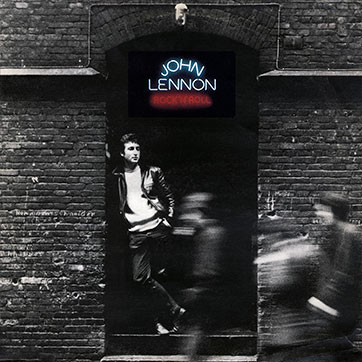 |
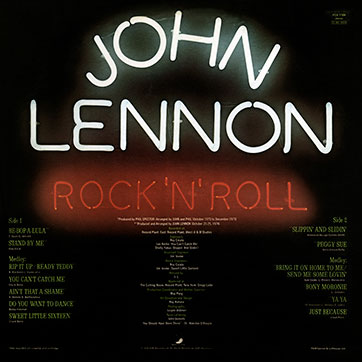 |
|
Matte cover, front side type 1 and type 2 Матова обкладинка, |
Matte cover, back side type 1 Матова обкладинка, |

Pic. 1. Matte cover, back side type 1 with text "Also available on cassette and cartridge"
- fragment (lower left corner)
Мал. 1. Матова обкладинка, зворотний бік тип 1 з текстом "Also available on cassette and cartridge"
- фрагмент (нижній лівий кут)

Pic. 2. Matte cover, back side type 2 without text - fragment (lower left corner)
Мал. 2. Матова обкладинка, зворотний бік тип 2 без тексту - фрагмент (нижній лівий кут)
![]()
Spine type 1 and type 2 - the front side of the cover up
Корінець тип 1 та тип 2 - обкладинка розташована лицьовою стороною до гори
![]()
Top edge type 1 and type 2, the view overlooking the top edge
Верхній торець тип 1 та тип 2, вид зверху
INNER SLEEVE
ВНУТРІШНІЙ ПАКЕТ
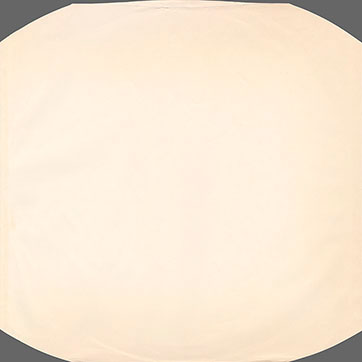 |
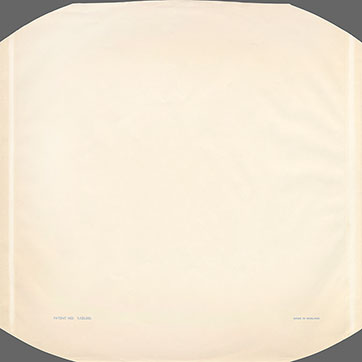 |
|
Type 1, front side Тип 1, лицьова сторона |
Type 1, back side Тип 1, зворотний бік |

Pic. 3. Inner sleeve type 1, back side - fragments (lower left and right corners)
Мал. 3. Внутрішній пакет тип 1, зворотний бік - фрагменти (нижній лівий і правий кути)
LABELS
ЕТИКЕТКИ
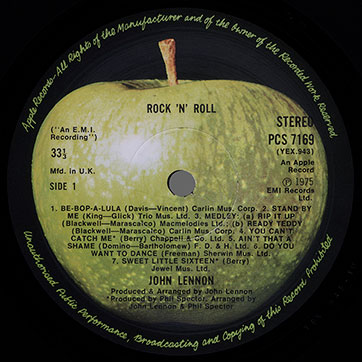 |
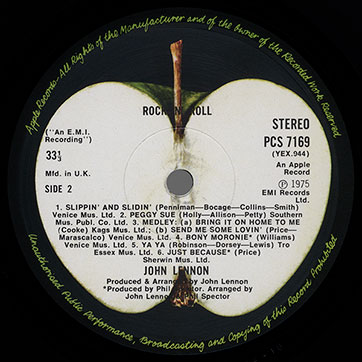 |
|
|
Type 1, side 1 Тип 1, сторона 1 |
||
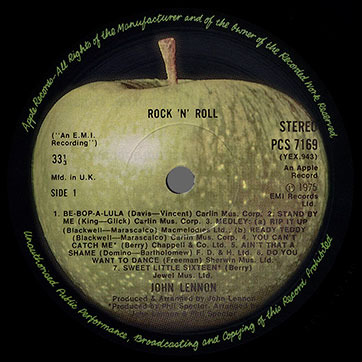 |
||
Type 2, side 1 Тип 2, сторона 1 |
For type 1 and type 2, side 2 Для тип 1 та тип 2, сторона 2 |
SECOND PRESSING (Late 70s)
ДРУГИЙ ПРЕС (Кінець 70-х)

Pic. 4. Glossy cover type 3, back side (as type 2) without text - fragment (lower left corner)
Мал. 4. Глянцева обкладинка тип 3, зворотний бік (як тип 2) без тексту - фрагмент (нижній лівий кут)
![]()
Spine type 3 - the front side of the cover up
(same as type 1 and type 2 but glossy surface)
Корінець тип 3 - обкладинка розташована лицьовою стороною до гори
(такий самий, як тип 1 та тип 2, але з глянцевою поверхнею)
![]()
Top edge type 3, the view overlooking the top edge
(same as type 1 and type 2 but glossy surface)
Верхній торець тип 3, вид зверху
(такий самий, як тип 1 та тип 2, але з глянцевою поверхнею)
INNER SLEEVE
ВНУТРІШНІЙ ПАКЕТ
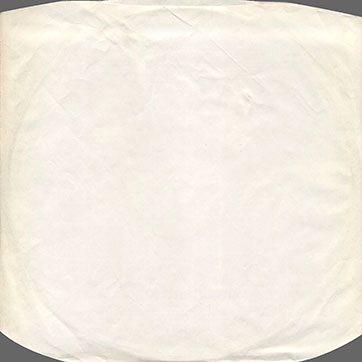 |
 |
|
Type 2, front side Тип 2, лицьова сторона |
Type 2, back side Тип 2, зворотний бік |
LABELS
ЕТИКЕТКИ
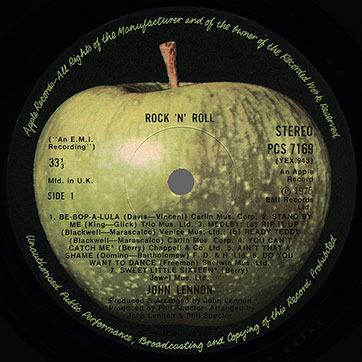 |
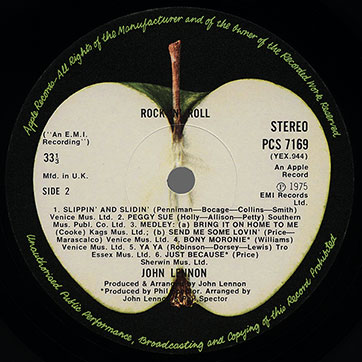 |
|
Type 3, side 1 Тип 3, сторона 1 |
Type 3, side 2 Тип 3, сторона 2 |
THIRD PRESSING (Early 80s)
ТРЕТІЙ ПРЕС (Перша половина 80-х)
The difference between the third and the second pressings is only in the absence of text on the top edge of the cover
and the presence of new matrix numbers on the dead wax zone of the record.
Відмінність третього преса від другого полягає лише у відсутності тексту на верхньому торці обкладинки
та наявності нових матричних номерів на збігу доріжок платівки.
|
see above див. вище |
see above див. вище |
|
Front side and label of side 1 Лицьова сторона та етикетка |
Back side and label of side 2 Зворотний бік та етикетка |
SIDE 1
N |
Titles and authors |
Time |
Comments |
1 |
BE-BOP-A-LULA ** (Davis—Vincent) |
2:36 |
Recorded 21st-25th October 1974 Originally a hit single for Gene Vincent in 1958. |
2 |
STAND BY ME ** (King—Glick) | 3:28 |
Recorded 21st-25th October 1974. A hit for Ben E. King in 1961. |
3 |
MEDLEY: a). RIP IT UP ** (Blackwell—Marascalco) b). READY TEDDY ** (Blackwell—Marascalco) |
1:33 |
Recorded 21st-25th October 1974. Both tracks were recorded by Little Richard in 1956, and released as two sides of one hit single. |
4 |
YOU CAN'T CATCH ME * (Berry) | 4:53 |
Recorded October-December 1973. Recorded by Chuck Berry in 1956. |
5 |
AIN'T THAT A SHAME ** (Domino—Bartholomew) | 2:30 |
Recorded 21st-25th October 1974. Oddly, first a hit for Pat Boone in 1955. |
6 |
DO YOU WANT TO DANCE ** (Freeman) | 2:52 |
Recorded 21st-25th October 1974. Originally by Bobby Freeman in 1958, first a hit here by Cliff Richard in 1962. |
7 |
SWEET LITTLE SIXTEEN * (Berry) | 3:00 |
Recorded October-December 1973. Originally a hit for Chuck Berry in 1958. |
SIDE 2
N |
Titles and authors |
Time |
Comments |
1 |
SLIPPIN' AND SLIDIN' ** (Penniman−Bocage−Collins−Smith) | 2:16 |
Recorded 21st-25th October 1974. The Little Richard B-side to "Long Tall Sally" in 1956. |
2 |
PEGGY SUE ** (Holly−Allison−Petty) | 2:02 |
Recorded 21st-25th October 1974. Buddy Holly 1957 hit. |
3 |
MEDLEY: a). BRING IT ON HOME TO ME ** (Cooke) b). SEND ME SOME LOVIN' ** (Price—Marascalco) |
3:40 |
Recorded 21st-25th October 1974. Bring It On Home To Me was originally by Sam Cooke in 1962, first a hit here for the Animals in 1965. Send Me Some Lovin' was Little Richard's B-side to "Lucille". |
4 |
BONY MORONIE * (Williams) | 3:47 |
Recorded October-December 1973. A 1957 hit for Larry Williams. |
5 |
YA YA ** (Robinson−Dorsey−Lewis) | 2:17 |
Recorded 21st-25th October 1974. Originally by Lee Dorsey in '61, it was first a hit here by Petula Clark in 1962. |
6 |
JUST BECAUSE * (Price) | 4:25 |
Recorded October-December 1973. Released originally by it's composer Lloyd Price in 1957. |
* Produced by PHIL SPECTOR / Arranged by JOHN and PHIL (October 1973 to December 1973)
* * Produced and Arranged by JOHN LENNON (October 21-25, 1974)
NOTE
It is an album of late 1950s and early 1960s songs as covered by John Lennon.
Recording the album was problematic and spanned an entire year: Phil Spector produced sessions in October 1973 at A&M Studios, and Lennon produced sessions in October 1974 at the Record Plant.
Indirectly, the story of the appearance of the album Rock 'N' Roll originates in 1969, when the Beatles recorded the song Come Together. With Chuck Berry himself, who borrowed only one line in the text, there were no problems. Chuck was even flattered. The opening line "Here come old flat top, he come grooving up slowly" was suspiciously reminiscent of "Here come old flat top, he was grooving up with me" from Chuck's 1956 song You Can't Catch Me. John acknowledged Berry's influence when he wrote this song, but denied outright plagiarism. However, Morris Levy, president of Roulette Records and head of Big Seven Music Corporation, which owns the publishing rights to the song You Can't Catch Me, sued Lennon for copyright infringement.
At the beginning of 1973, Levy put forward a condition - to record a couple of songs from his catalog on Lennon's albums, and then they would be "in the calculation" with Lennon.
The 74th year has come. Sensing trouble looming, John recorded Ya-Ya on Walls and Bridges album, but Levy demanded a meeting, stating, "Who were you kidding?".
Lennon realized that he needed to finish the project and quickly!
In two days he recorded a dozen songs plus three tracks from the sessions with Phil Spector.
At this point, John lived for a couple of weeks at Levy's dacha in California and communicated with him quite peacefully. At lunch, he gave Levy a rough-recorded Rock 'N' Roll cassette to confirm that the job was done.
The album was almost ready. Apple/Capitol put it on release 6 months after Walls and Bridges was released.
But Levy threw out the trick - he released the record Roots from the cassette handed to him. The record was released on his own Adam VIII label, which sold the discs by mail order.
Capitol was alarmed and sued. The release of Roots was put on hold and preparations for the release of Rock 'N' Roll were rushed in order not to lose the market.
Levy responded by suing John for $42 million.
The case dragged on for a year. Levy lost, paid his legal fees and paid a small settlement.
Well, the quickly released Rock 'N' Roll came out in February '75. Although, and was scheduled for April.
Its difference from Roots is the song Angel Baby. It was officially released only in '86, on the album Menlove Ave..
Lennon planned to use some of his childhood drawings for the cover of his oldies album, and production had already begun when Lennon switched gears, so the artwork was used instead for Walls and Bridges. In September 1974, May Pang attended the first Beatlefest convention at Lennon's behest, and met Jürgen Vollmer, an old friend of the Beatles from Hamburg, Germany, who had photographed the band from their Hamburg days. He was selling some striking portraits, and Pang immediately phoned Lennon to tell him of her find. Reuniting with Vollmer in New York, Lennon chose one of his photos for the album's cover.
The photo depicts Lennon in a doorway with three blurry figures walking past him in the foreground. Those figures are George Harrison, Stu Sutcliffe and Paul McCartney. It was taken on 22 Wohlwill Street in Hamburg.
The album's working title had been Oldies But Mouldies; no official title had been chosen until Lennon saw the neon sign prepared as cover art by John Uomoto, with Lennon's name and the words ROCK 'N' ROLL beneath. This struck Lennon in a positive way, and it became the album title.
So, the main signs of the first pressing:
The cover of the record has a matte surface. JOHN LENNON • ROCK N ROLL is printed in black on the top of the spine, and the catalog number PCS 7169 is printed on the bottom in white. The same is printed on the top edge. On some copies these prints may not be visible due to some shifting when a cover has been assembled.
There are 2 types of envelopes:
Type 1 with the statement "Also available on cassette and cartridge" on the back cover at the bottom left and
Type 2 - without this statement.
The second type appeared a little later.
Labels have a light apple. They are also of 2 types.
Type 1 - On the side 1 label, STAND BY ME is credited to Trio Mus. Ltd.
Type 2 - the credit for the same song has already been changed to Carlin Mus. Corp.
Label of side 2 is the same for both types.
Matrix numbers:
Side 1: YEX 943-1U SK-1-3419-Z9 MCR
Side 2: YEX 944-1U SK-2-3419-Z9
or
Side 1: YEX 943-1U SK-1-3419-Z9 MCR
Side 2: YEX 944-1U
where:
SK-1-3419-Z9 and SK-2-3419-Z9 are US numbers. Their presence is explained by the fact that the mastering of lacquer discs for England was carried out in the USA.
MCR stands for "Master Cutting Room", the lacquer-cutting department at The Record Plant where the album was recorded. Master Cutting Room was located in New York, in the premises of one of the studios of The Record Plant. Engraved at 180 degrees opposite US number.
British matrix numbers are machine-stamped (YEX 943-1U and YEX 944-1U), while American numbers are hand-engraved (SK-1-3419-Z9 MCR and SK-2-3419-Z9).
Inner sleeve:
The inner covers are white with an inscription on the reverse side in blue font PRINTED NO. 1,125,555 in the lower left corner and MADE IN ENGLAND in the right. All corners are rounded.
The main features of the second pressing:
The cover of the record has a glossy surface (type 3). Outwardly, the envelope resembles type 2 (there is no statement on its back side). The only difference is the material from which the cover is made. The inscriptions on the spine and on the top edge remained unchanged.
The labels have a light apple too and only one type, namely:
Type 3 - STAND BY ME is again credited to Trio Mus. Ltd.
And for the composition RIP IT UP, the credit has changed from Macmelodies Ltd. at Venice Mus. Ltd.
There were no changes in the side 2 label design compared to the previous ones.
Matrix numbers:
Side 1: YEX 943-1U SK-1-3419-Z9 MCR
Side 2: YEX 944-3U
On side 2 is a new cut of the YEX 944-3U matrix.
Inner package:
Copies predominantly feature type 2 from EMI with text within "Care Of Your Record..." and "Important Notice". Black font on earlier packs, blue font on later copies. But, there are also instances with Type 1 internal packages.
The main features of the third pressing:
The cover of the record has a glossy surface (as type 3). Outwardly, it remained similar to the version of the second press, with the exception of the top edge, on which the inscription is already missing.
Labels of both sides remain unchanged.
Matrix numbers changed to:
Side 1: YEX 943-4
Side 2: YEX 944-4 HTM
where:
HTM are the initials that belong to British mastering engineer Harry T. Moss.
Exactly the same matrix numbers present on the budget edition of label Music For Pleasure (MFP 30522), which was released at the end of November 1981.
ПРИМІТКА
Це альбом з рок-н-рольних каверів кінця 1950-х — початку 1960-х років у виконанні Джона Леннона.
Запис альбому був проблематичним і тривав цілий рік: Філ Спектор продюсував сесії в жовтні 1973 року в A&M Studios, а Леннон продюсував сесії в жовтні 1974 року на Record Plant.
Побічно історія появи альбому Rock 'N' Roll бере свій початок у 1969 році, коли Бітлз записали пісню Come Together. Із самим Чаком Беррі, у якого було запозичено лише один рядок у тексті, проблем не було. Чак навіть був задоволений. Перший рядок "Here come old flat top, he come grooving up slowly" підозріло нагадувала рядок "Here come old flat top, he was grooving up with me" із пісні Чака 1956 року You Can't Catch Me. Джон визнав вплив Беррі, коли писав цю пісню, але заперечив прямий плагіат. Проте, Морріс Леві - президент Roulette Records і глава корпорації Big Seven Music, що володіє видавничими правами на пісню You Can't Catch Me, подав на Леннона до суду за порушення авторських прав.
На початку 73-го року Леві висунув умову - записати кілька пісень з його каталогу на альбомах Леннона, і тоді з Ленноном вони будуть "в розрахунку".
Настав 74-й рік. Відчуваючи неприємності, що насуваються, Джон записав Ya-Ya на альбомs Walls and Bridges, але Леві зажадав зустрічі, і заявив: "Кого ти хотів обдурити?".
Леннон зрозумів, що потрібно закінчувати проект і швидко!
За два дні він записав десяток пісень плюс три треки із сесій із Філом Спектором.
У цей момент Джон жив кілька тижнів на дачі Леві в Каліфорнії і цілком мирно з ним спілкувався. За обідом він віддав Леві касету з чорновими записами Rock 'N' Roll, щоб підтвердити, що роботу зроблено.
Альбом був майже готовий. Apple/Capitol поставили його реліз через 6 місяців після виходу Walls and Bridges.
Але Леві викинув фортель - він випустив платівку Roots з переданої йому касети. Платівка вийшла на його власному лейблі Adam VIII, який продавав диски поштою.
Capitol сполошилася і подала до суду. Реліз Roots призупинили і стали різко готувати до випуску Rock 'N' Roll, щоб не втратити ринок.
А Леві у відповідь подав позов до Джона на 42 млн. $.
Розгляд справи затягнувся на рік. Леві програв, оплатив судові витрати і заплатив невелику компенсацію.
Ну, а швидко виданий Rock 'N' Roll вийшов у лютому 75-го. Хоча, і був запланований на квітень.
Його відмінність від Roots - пісня Angel Baby. Офіційно її було випущено тільки у 86-му, на альбомі Menlove Ave..
Леннон планував використати деякі зі своїх дитячих малюнків для обкладинки свого альбому старих пісень, і виробництво вже розпочалося, коли Леннон перемкнув передачу, тож натомість обкладинку було використано для Walls and Bridges. У вересні 1974 року Мей Пенг відвідала перший з'їзд Бітлфесту за вказівкою Леннона і зустріла Юргена Воллмера, старого друга Бітлз із Гамбурга (Німеччина), який фотографував групу під час їхніх гамбурзьких днів. Він продавав кілька приголомшливих портретів, і Пенг негайно зателефонувала Леннону, щоб повідомити йому про свою знахідку. Возз'єднавшись із Фоллмером у Нью-Йорку, Леннон вибрав одну зі своїх фотографій для обкладинки альбому.
На фотографії Леннон зображений у дверному отворі, а повз нього на передньому плані проходять три розмиті фігури. Це Джордж Гаррісон, Стю Саткліфф і Пол МаКкартні. Знімок було зроблено на вулиці Wohlwill 22 у Гамбурзі.
Робоча назва альбому була Oldies But Mouldies; офіційну назву не було обрано доти, поки Леннон не побачив неонову вивіску, підготовлену як обкладинку Джоном Уомото, з ім'ям Леннона і словами ROCK 'N' ROLL під ним. Це справило на Леннона велике враження і стало назвою альбому.
Отже, основні ознаки першого преса:
Обкладинка платівки має матову поверхню. Зверху на корінці знаходиться напис чорним шрифтом JOHN LENNON • ROCK N ROLL, а внизу білим шрифтом надруковано каталожний номер PCS 7169. Такий самий напис є і на верхній кромці. На деяких копіях ці відбитки можуть бути не помітні через деякий зсув під час складання обкладинки.
Існує 2 типи конвертів:
Тип 1 із заявою "Also available on cassette and cartridge" з зворотного боку зліва внизу і
Тип 2 – без цієї заяви.
Другий тип з'явився трохи пізніше.
Етикетки мають світле яблуко. Вони теж 2-х типів.
Тип 1 – на етикетці сторони 1 композиція STAND BY ME має кредит Trio Mus. Ltd.
Тип 2 – кредит для цієї ж композиції вже змінено на Carlin Mus. Corp.
Етикетка сторони 2 для обох типів однакова.
Матричні номери:
Сторона 1: YEX 943-1U SK-1-3419-Z9 MCR
Сторона 2: YEX 944-1U SK-2-3419-Z9
або
Сторона 1: YEX 943-1U SK-1-3419-Z9 MCR
Сторона 2: YEX 944-1U
де:
SK-1-3419-Z9 та SK-2-3419-Z9 - американські номери. Їхня наявність пояснюється тим, що мастеринг лакових дисків для Англії здійснювався у США.
MCR - означає "Master Cutting Room" - відділення нарізки лакових дисків студії The Record Plant, де записувався альбом. Master Cutting Room розташовувалася в Нью-Йорку, у приміщеннях однієї зі студій The Record Plant. Вигравірувано через 180 градусів навпроти американського номера.
Британські матричні номери вибиті машинним способом (YEX 943-1U та YEX 944-1U), а американські вигравірувані від руки (SK-1-3419-Z9 MCR та SK-2-3419-Z9).
Внутрішній пакет:
Внутрішні пакети білі з написом зі зворотного боку синім кольором PRINTED NO. 1,125,555, у лівому нижньому кутку і MADE IN ENGLAND - у правому. Усі кути закруглені.
Основні ознаки другого преса:
Обкладинка платівки має глянцеву поверхню (тип 3). Зовні конверт нагадує тип 2 (заява на його зворотному боці відсутня). Різниця тільки в матеріалі, з якого виготовлена обкладинка. Написи на корінці та на верхній кромці залишилися без змін.
Етикетки теж мають світле яблуко і бувають тільки одного типу, а саме:
Тип 3 - композиція STAND BY ME знову має кредит Trio Mus. Ltd.
А для композиції RIP IT UP кредит змінився з Macmelodies Ltd. на Venice Music Ltd.
У дизайні етикеток сторони 2, порівняно з попередніми, жодних змін не було.
Матричні номери:
Сторона 1: YEX 943-1U SK-1-3419-Z9 MCR
Сторона 2: YEX 944-3U
На стороні 2 нова нарізка матриці YEX 944-3U.
Основні ознаки третього преса:
Обкладинка платівки має глянцеву поверхню. Зовні вона залишилася схожою на варіант другого преса за винятком верхньої кромки, на якій напис уже відсутній.
Етикетки обох сторін залишилися без змін.
Матричні номери змінилися на:
Сторона 1: YEX 943-4
Сторона 2: YEX 944-4 HTM
де:
HTM – ініціали, які належать британському мастеринг-інженеру Harry T. Moss.
Точно такі ж матричні номери присутні на бюджетному виданні лейбла Music For Pleasure (MFP 30522), що вийшов наприкінці листопада 1981 року.